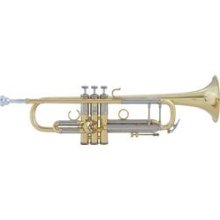 To hear the Trumpet, click HERE.
To hear the Trumpet, click HERE.
The trumpet or cornet is the smallest and highest member of the brass family. As with all brass instruments, the sound is produced by buzzing the lips into a mouthpiece. The difference between a trumpet and cornet is very minor. They both play the same notes and they sound virtually the same. In appearance, the trumpet looks a bit longer and more slender than a cornet. The real difference has to do with the way the tubing of the instrument flares. A cornet is more cone shaped or conical than a trumpet. For all practical purposes they are the same instrument for beginners. A band teacher may refer to the trumpet section when he or she really means all trumpets and cornets. Either is a good instrument for a beginner.
Taking care of a trumpet is easier than a woodwind instrument. It is stored in the case in just two pieces. The only regular maintenance required is to oil the valves now and then and grease the slides as needed.
The trumpet is played with the right hand on top of the instrument with the first three fingers resting on the valves. The left hand holds the instrument with the fingers wrapped around the middle of the valves.
Advanced players may have a trumpet and a cornet and several other sizes of trumpets. They may perform on a “C” trumpet, “D” trumpet or even a piccolo trumpet. The most common version is a Bb (“B” flat) trumpet or cornet. All beginning trumpet players should start on a Bb instrument.
The trumpet is certainly one of the most popular instruments for young players. Since lots of other students will choose the trumpet, there will be more competition with other players.
However, the trumpet is a very versatile and widely used instrument. Trumpets are always needed in bands, symphony orchestras, jazz groups and small instrumental groups. It is very common for the trumpet to perform a large number of solos and melodic lines in all of these groups. The trumpet also works well as a solo instrument.
